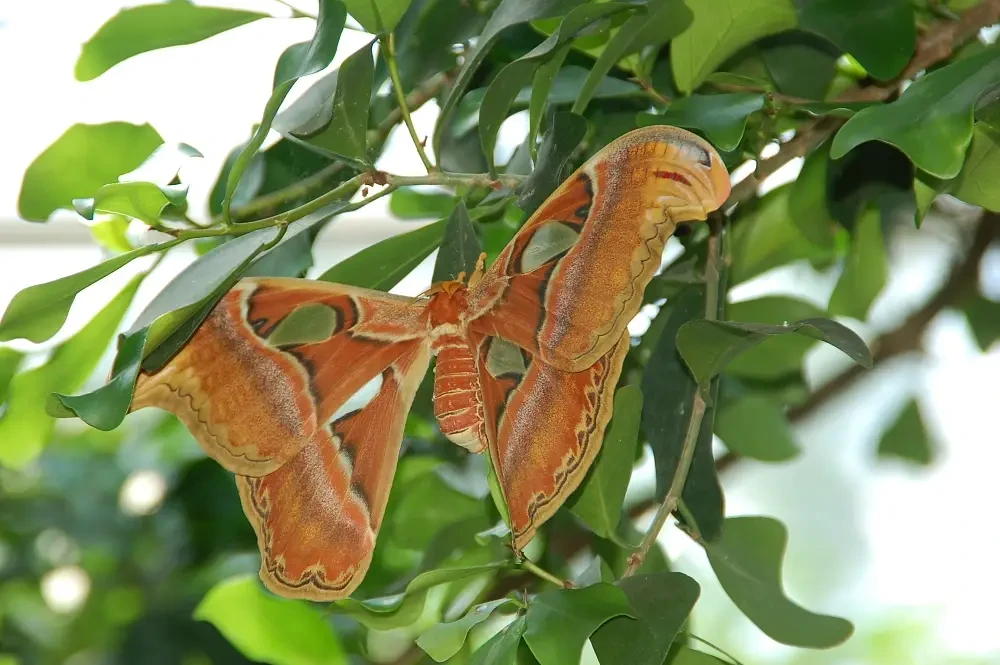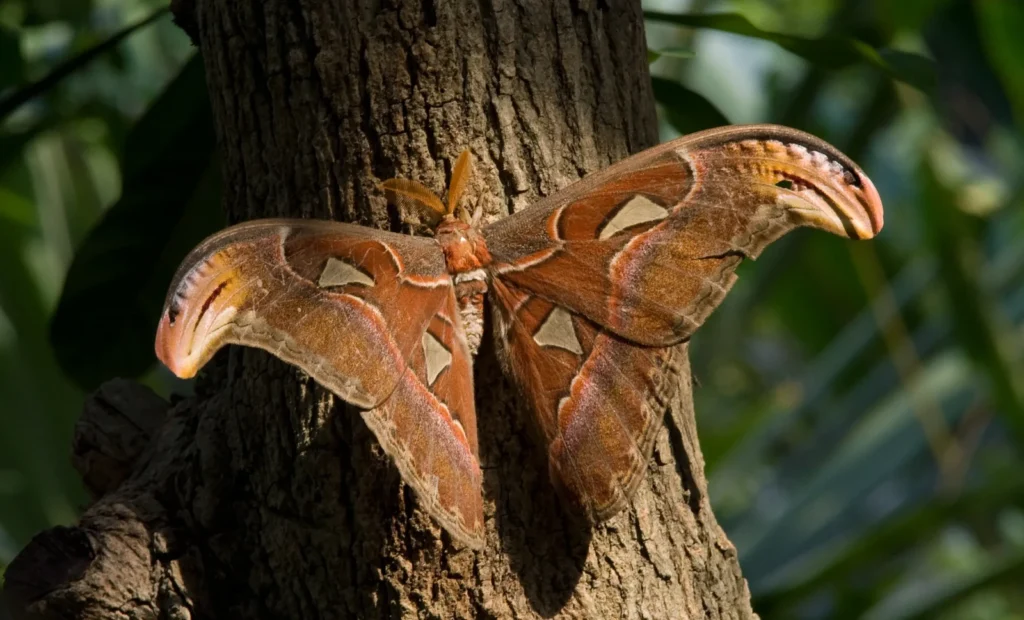Attacus atlas, or satin butterfly with peacock eyes,- one of the the biggest butterflies in the world. Its wingspan can reach up to up to 30 cm, and the area of wings – up to 400 cm2. This giant lives in tropical forests of Southeast Asiawhere it fascinates with its striking color and special shape of the front wings, which resemble the head of a snake.
Satin butterflies – night creationsthose who do not have a developed oral apparatus, so their goal after leaving the pupa is to find a partner for reproduction. They live just 5-7 daysusing accumulated nutrient reserves from the caterpillar stage.
In this article, we will look at structure, habitat, life cycle, behavior, natural enemies, interesting features and role of this butterfly in nature.

Scientific classification
🔬 Classification of satin butterflies:
✔ The Kingdom: Animals (Animalia)
✔ Type: Arthropods (Arthropoda)
✔ Class: Insects (Insecta)
✔ Row: Lepidoptera (Lepidoptera)
✔ Family: Peacock eyes (Saturniidae)
✔ Gender: Attacus
✔ View: Satin butterfly (Attacus atlas)
📌 Interesting!
Title Attacus it comes from the Greek word meaning " grandiose”, and atlas "in honor of the titan Atlas, who held the firmament on his shoulders."
Appearance and features of the structure
Satin Butterfly – a real giant among the moths.
, Main Features:
✔ Wingspan: 25-30 cm
✔ Color scheme: red-brown with beige and black patterns
✔ Wing shape: the upper edges have a curved shape, resembling the head of a snake
✔ Oko: large, complex projects
✔ Tentacle: pinnate (more developed in males)
✔ Body: small, covered with thick hairs
🔹 Key features of painting:
, Main color – dark red or brownish red
✅ Each wing has transparent " windows”framed by black lines
✅ The upper part of the front fenders has serpentine pattern, repels predators
📌 Interesting!
In Taiwan, this butterfly is known as "snake butterfly "because when threatened, it folds its wings to mimic the head of a snake.
Habitat and distribution
🌍 Where does the satin butterfly live?
This type is common in tropical and subtropical regions of Asia.
✅ Distribution regions:
• India
• Sri Lanka
• China
• Indonesia
• Malaysia
• Philippines
• Thailand
🔹 Typical habitats:
✅ Tropical rainforests
Джунг Jungle and mangroves
✅ Plantations and gardens
📌 Interesting!
In India, cocoons of satin butterflies are used for making wild silk, which has a rougher texture than that of the silkworm (Bombyx mori).

Life cycle and reproduction
The life of a satin butterfly consists of four main stages.
Стадії стадии развития:
✅ Egg - 10-14 days
✅ Caterpillar - 4-6 weeks
✅ Pupa - 3-4 weeks (sometimes winters)
✅ Imago (adult butterfly) - 5-7 days
🔹 How does the satin butterfly reproduce?
✔ Female lays eggs up to 150 eggs on the leaves of plants
✔ After 2 weeks, the eggs hatch tracks, which grow to 12 cm
✔ Caterpillar builds durable cocoon, in which it turns into a chrysalis
✔ An adult butterfly does not have a mouthpiece, so it only lives for a few days, using the energy accumulated in the caterpillar stage
📌 Interesting!
Males find females using the sense of smell "their feathery antennae pick up pheromones from a distance up to 3 km.
Food habits and role in nature
What does the satin butterfly eat?
✅ Caterpillar:
• Leaves mango, citrus, cinnamon, guava
• Leaves rubber-bearing trees
✅ Imago (adult butterflies):
• They don't eat - they live off their energy reserves
🔹 What role does the ecosystem play?
✔ Controls the plant populationby eating their leaves
✔ Serves as food for birds and bats
📌 Interesting!
Although the caterpillar of the satin butterfly eats a lot of leaves, it is not considered a dangerous pest.

Natural enemies and threats
🔹 Who hunts the satin butterfly?
✅ Birds-woodpeckers, magpies
Па Spiders-catch young caterpillars
✅ Bats-hunt adult butterflies
🔹 Main threats:
⚠ Deforestation
⚠ Collecting cocoons for making silk
⚠ Climate change
📌 Interesting!
In some regions, the satin butterfly is bred in laboratories for studying insects and getting silk.
Interesting facts about the satin butterfly
✔ One of the largest butterflies in the world
✔ Its wings resemble the head of a snake
✔ Does not eat in adulthood
✔ Its cocoons are used for the production of wild silk
Conclusion
Attacus atlas – a unique representative of the butterfly world, which impresses with its size, color, and protective mechanisms.
📢 Preserving the rainforest is the key to preserving this majestic view!